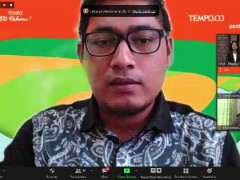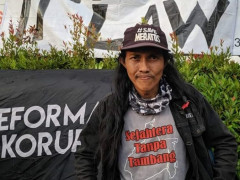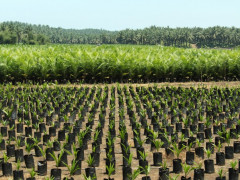Companies Have Not Fulfilled Peat Restoration Mandate
By Pantau GambutPantau Gambut Joins KBR Radio Talk Show for Casual Chat

On Thursday, 31 May 2018, Pantau Gambut Researcher Clorinda Wibowo and Head of WALHI National Executive Campaign Khalisah Khalid joined the “Public Space” talk show on Radio News Office (KBR) to discuss government pledges to protect and restore peatlands. The theme of the discussion was “Where are Environmental Issues in the 2018 Regional Elections?”
The rapid conversion of peat forests into plantations is worrying. In the 2000s, peatlands in Sumatra still covered as much as 15 million hectares. By 2016, only 13 million hectares remained. However, peatlands are very valuable due to their capacity to store large amounts of carbon – 20 times as much carbon as other tropical rainforests.
This is one reason why the government issued Presidential Regulation No. 1/2016 on the Peatland Restoration Agency (BRG) to restore 2 million hectares of peatlands in seven priority provinces. In the implementation of this regulation, the role of regional governments cannot be put aside. So, Pantau Gambut researched the sustainability of regional peatland protection pledges in the context of the 2018 regional election cycle in peatland restoration priority regions.
On 31 May, Radio News Office (KBR) hosted Clorinda Wibowo, a researcher at Pantau Gambut and WRI Indonesia, and Khalisah Khalid, head of the WALHI National Executive Campaign Department, to discuss government pledges to protect and restore peatlands. The theme of the talk show was “Where Are Environmental Issues in the 2018 Regional Elections?”
For an hour, Clorinda and Khalisah talked about peatlands and explained why this important issue should be brought to the surface in this regional election cycle.
Who is responsible for peatland restoration activities?
Clorinda Wibowo (CW): The issue of peatland restoration first started from the 2015 forest fires. After the incident, President Jokowi issued Presidential Regulation No. 1/2016 on BRG. In the regulation, he established BRG to coordinate the restoration of 2 million hectares of peatland by 2020.
There are actually many actors responsible for peatland restoration, not just BRG. Ministries and other institutions are also required to participate, including the Ministry of the Environment and Forestry and – most importantly – regional governments. Regional governments are actually mandated to appoint peatland restoration teams in their provinces and regencies, to coordinate with BRG and immediately begin restoration efforts.
What about Pantau Gambut? How long has the coalition been running?
CW: Our concern began at the same time as peatland restoration began. We are a collection of 19 non-governmental organizations (NGO) taking the initiative to assist the government in monitoring regional peatland restoration on the ground, because it is very widespread – 2 million hectares across Indonesia. Strong participation from the community is clearly needed in this case, and yet we see that local communities are still not fully and optimally involved.
Locals actually have a lot of knowledge that can accelerate peatland restoration. That’s why we set up Pantau Gambut, which essentially is a coalition of 19 NGOs, with the primary objective of increasing public participation in peatland restoration. We established the coalition in 2016.
What is the Indonesian Forum for the Environment (WALHI)’s role in peatland restoration?
Khalisah Khalid (KK): The 2015 forest fires were the culmination of a crisis for peatland ecosystems. The process of destruction has actually been going on for a very long time. If we remember the 1997 forest fires, those were also mostly in peatland ecosystems. Until finally in 2015, after reaching its peak, we were faced with a truly dire situation. This is because peatland ecosystems are essential, and they have been illegally devastated by massive extractive industries like oil palm plantations and Industrial Plantation Forest (HTI) concession holders.
Many investors have joined these industries and increased production by creating canals, which eventually led to the 2015 forest and peatland fires. So, there are many problems, including the fact that the government ignores this!
There are communities that have traditionally lived in peatlands. Yet, when it comes to management permits, most are given to corporations. The practice is very greedy, of course, and contrary to existing regulations.
WALHI has monitored this. By our recollection, in 1997, 1 million hectares of peatland were converted to rice fields during the New Order period [under President Suharto]. This system has been proven to collapse, and yet such models of peat management continue.
What is Pantau Gambut currently working on?
CW: For the last two years, we have been working on monitoring peatland restoration on-the-ground. But that was preceded by a review of related policies. So, we identify both direct and indirect government pledges related to BRG-led peatland restoration.
For instance, the government established a moratorium on new permits and land clearing in primary forests, including the peatlands therein. Well, we monitor that because peatlands in Indonesia don’t just span 2 million hectares. They cover 14.9 million hectares. So, here we have a vast area of land that must be protected and restored.
In the latest Pantau Gambut research initiative, over the past few months, we studied peatland restoration pledges in regional elections – assessing candidates’ visions and missions for peatland restoration work and whether pledges will be followed through with by newly-elected leaders.
How can we maintain and protect peatlands?
CW: Peat is actually very strong and inviolable. Yes, peat is like that in its most natural condition. However, in reality, peatlands burn easily, because the peat has been dried. Corporations often dry out peatland before making canals to serve production. But in fact, peat itself is a water reservoir.
So, how do we keep peat in its natural condition? First, law enforcement – laws to restore and protect peat and primary forests – so that corporations can’t simply clear and dry out peatlands.
Meanwhile, in terms of community, many locals are already aware of the importance of peatlands. Many of them are already affected by the degradation of peatland in their areas, as well as the fumes from resulting fires that degrade their health, among other things. Knowledge from local people, such as land clearance methods that avoid burning, will preserve peatlands.
BRG has set a strategic plan to restore peatlands from 2016-2020. Which area is the next target?
KK: Yes, the target is already in place in seven priority provinces. It is actually being monitored by our friends at Pantau Gambut and other civil society organizations (CSOs). However, we’re concerned that the restoration target of 2 million hectares of peatland is very ambitious, because most of this land is managed by corporations, so it’s quite challenging.
On one hand, Presidential Regulation No. 1/2016 does not actually mandate BRG to enforce the law. There is another institution, the Ministry of the Environment and Forestry, which holds this authority. So in any case, proper coordination between various ministries and state institutions is required.
We know that ego restricts productive collaboration between government bodies. That is something for state institutions to solve. We are also concerned about law enforcement for corporations. We see a lot of BRG cooperation with companies, so companies are obliged to conduct restoration efforts without negating law enforcement.
This is the cyclical dilemma. When companies violate the law by destroying their concession land, by law, the land must then be restored, at which point the companies’ operations are moved to new mineral land. The same risk is present with concessions on peatlands. Basically, it's like passing on a crisis in one ecosystem to another ecosystem. This is our concern, and it’s a challenge for BRG.
In addition to oil palm plantations, local communities have also traditionally cultivated peatlands. How can we overcome this?
KK: We’ve conducted research on community governance models in peatlands. This research revealed that local people already practice migratory farming and other approaches based on local wisdom. This is different from corporations. They do not practice monoculture and, because their farming practices are based on ancestral beliefs, they perform rituals before clearing any land. They believe that prevents the fire from spreading. There are customary punishments applied if the fire spreads from their land. Those are their beliefs. Our research also showed that indigenous people’s tradition of rotating cultivation follows a community-managed model proven not to cause large-scale fires.
In fact, President Jokowi’s experience visiting the Tohor river also led him to admit that the best method is to put management in the hands of local communities, not corporations that practice monoculture. Tohor proved that peatland managed by the local community is safe from fire. In addition to practicing monoculture, corporations damage the natural condition of peat by draining it, whereas local people adapt to its natural conditions. That's the difference.
Is it compulsory for regional candidates to include environmental issues in their campaign platforms?
CW: It depends on the candidates themselves. But, if we compare it to other national priority issues, Indonesia has suffered losses of up to IDR 200 trillion due to the 2015 forest fires – not to mention the impact on public health and the number of jobs lost. Given this level of urgency, candidates running in the gubernatorial elections should be aware of these issues, so that in the future they can implement relevant programs and solve them. On top of that, peatland restoration has been set forth as a national priority directly by President Jokowi.
In some regions, corruption in regional elections is inevitable, which impacts environmental issues, such as the allocation of land clearance permits to corporations. But if citizens do not vote, it's likely that their voices will be misappropriated. How can we address this issue?
KK: In my opinion, the General Election Commission needs to get involved in this matter. If we expect candidates who are aware of peatland issues, that is indeed difficult, because environmental issues are still considered marginal. If we see this as urgent, electoral organizers must take the initiative to establish and enforce laws, including laws on electoral funding. What we find is that many permits are allocated in the lead up to gubernatorial elections purportedly in line with revised spatial layout plans. That is perhaps how political transactions have been conducted through permit allocation.
In addition to the General Election Commission, the Corruption Eradication Commission should also be involved in this process. KPK itself has stated that environmental loss is a loss for the state. Regional incumbents should be warned that when they give permits to companies, this is equivalent to supporting state losses.
How important is it for regional gubernatorial candidates to campaign for peatland restoration issues, and how would this support BRG’s effort?
CW: When it comes to peatland restoration, we will see a domino effect. Environmental damage negatively impacts biodiversity, which, in turn, causes public health and employment issues. This shows that environmental issues are in fact closely related to other priority issues, such as the economy and infrastructure development. Our hope in this gubernatorial election is that the candidates show awareness of environmental issues. There are 32 incumbents who can actually link peatland restoration to economic, social, and infrastructural issues.
What has been done to protect peatland and prevent forest fires so far has actually not been very effective, since peatland fires or burnings still frequently occur. Is there a way to save Indonesia’s peatlands?
KK: One of the ways is through restoration. If implemented consistently, the peat ecosystem can be restored, which at the moment is a worrying situation. Adding to what Clorinda said about the urgency of regional governors acknowledging peatland issues, the development of a regional peat restoration team plays an important role. Peat restoration teams fall under the governor’s authority, and we know when anything falls under the governor’s authority, the governor's interests dominate. We also know that sometimes there is a gap between the central and regional peat restoration teams, so we need to make sure that the governor is committed to bridging this.
How is the 2-million-hectare peatland restoration program progressing in the seven priority provinces?
CW: We are waiting for a report from BRG which was due to come out this March 2018. As of now, it’s still not out. Actually, Presidential Regulation No. 1/2016 has already established how much land should be restored per year: 600 thousand hectares in the first year, then 400 thousand hectares in the second year, and so on until 2020.
BRG itself has developed Peat Care Villages scattered throughout the region. This program serves to revitalize community economies. Then, there is also a wetting program to prevent the drying of peat. However, in terms of measurable impact, we don’t yet have an exact figure.
Have BRG and the Regional Election Commissions partnered to support gubernatorial candidates’ campaigns?
KK: Not that I know of.
But, is there a plan for that?
KK: BRG should take the initiative to establish communication with the General Election Commission, because efforts should begin at the central headquarters. Only afterward that can we, the the Regional Election Commission, be asked to cooperate. This is what WALHI actually did. Political communication with the General Election Commission is a long process. On top of that, the presidential debate in 2014 included environmental issues. I think BRG can take the initiative.
Are they being encouraged to forge a partnership? What would this look like? Who is leading the process?
CW: In terms of the government encouragement, as far as I know this not happening yet. But in terms of encouragement from the public, well, it is like what Pantau Gambut is doing at the moment, for instance. After completing research, we follow up by disseminating the results at the regional level. For example in Riau, we just conducted a press conference. To date, of all the candidate pairs, only two have mentioned peatland restoration in their pledges. Those two candidate pairs are governor and vice governor candidates in South Sumatra and regent and vice regent candidates in Central Kalimantan.
The central government has its own regulation. How does the government ensure this regulation is really implemented?
KK: The synergy between the central government and regional governments of course becomes very important. Decentralization is also a concern, because it is common for regional governors to use their authority to disobey the rules. One example is when the governors of West Kalimantan and South Sumatra sent the president a letter requesting an exception to the moratorium for company permits on the grounds that what’s done is done, and it’s too late to reverse it. This is a challenge to our bureaucracy.
The study conducted by Pantau Gambut says that most regional heads focus on economic or political issues over environmental issues. Why is this?
CW: Economic and infrastructure development issues are more attractive to the public, as most of them, especially in the suburbs, are very concerned about the economy and infrastructure. Whereas, based on our 100-person public opinion survey, 98 respondents felt that peatland restoration, and environmental issues in general, need to be incorporated in the gubernatorial election and the visions and missions of candidates. Unfortunately, the candidates see economic, infrastructural, and environmental issues as disconnected. It would actually be better if a stronger narrative is built connecting these three issues.
If a public survey has already been conducted, and 98 percent of responses show concern for the environment, what steps is Pantau Gambut taking in regional gubernatorial campaigns?
CW: We are disseminating our research findings as much as possible, especially at the local level. We also hope that the public, who hear or read our research results, will become more aware of which candidates have a strong vision for the environment. It’s no surprise that the public will be critical in encouraging the inclusion of environmental issues in the candidates’ programs, in the gubernatorial election cycle and beyond.
There are only two candidate pairs in regional elections that have mentioned peatlands in their programs. So how do we make legislators want to talk about the environment, and how do we make people choose candidates who care about the environment?
KK: We tracked legislative candidates once back in 2014 and found that, out of 6,000 candidates, only 7% were committed to environmental issues. Of that 7%, only 0.2% was elected. So it is perfectly natural that those now sitting in parliament never speak out on environmental issues, especially peatland restoration. In fact, the role of the parliament is important here because, as we know, Indonesia is ratifying the Paris Agreement on climate change.
The challenge is with voters. Because if we talk about politics – and this is a political year – I think citizens’ political awareness is important to ensuring that amidst the strength of identity politics, we continue to build public discourse around the importance of the environment for all of us. Inevitably, it must be a pledge from regional gubernatorial candidates, legislative candidates, and presidential candidates.
This is a political year of challenge and threat. Often, corporations ride political agendas, so we should be cautious that environmental issues are not only addressed on the surface, but also consider deeper structural problems. This should start from the critical awareness of citizens, especially young people.
As for Pantau Gambut, what are the toughest challenges faced in implementing the restoration program of 2 million hectares of peatland?
CW: The hardest part is following up with government pledges. But, which government are we talking about? I agree with Khalisah Khalid that the key is synergy – synergy among ministries, institutions, and regional governments. That’s the most important and difficult point since different institutions are sometimes driven by their egos. How can the public advocate for their aspirations, if there is no encouragement from the government?
We must be critical. However, what if our chosen candidates do not want to accept criticism?
KK: After the election, the next assignment – both for us and for the public – is to monitor Medium-Term Development Plans. This is how candidates’ programs will be implemented. I think citizens can urge the government to involve the public in ensuring that political promises are fulfilled. Our criticism is of course not just in the voting booths, but also throughout the implementation of candidates’ pledges.
In early 2017, WALHI issued a study on public governance in peat swamp ecosystems and lessons learned from various snapshots and counterarguments. Could you summarize that?
KK: This is a study on how local knowledge in peatland management has not been acknowledged by the government. The government trusts as much as 1.4 million hectares to corporations, which is used as concession land. Whereas, in fact, community peatland management is much more sustainable, and this has been proven. Our research has shown this, so now the important question is how to encourage state recognition of local communities’ expertise.
We also promote law enforcement in relation to corporate environmental destruction. As we know, the president has made a pledge to ban new permits in peatlands. Well, this must be paralleled with permit review procedures and law enforcement so that companies are deterred from violations and the peatland recovery agenda does not contrast with companies’ impunity.
In relation to regional elections, are there further programs planned to support the national 2 million hectare peatland restoration target? Or any public education programs?
CW: Pantau Gambut itself campaigns a lot. In the short term, our campaign strategy is focused on this election cycle. In the longer run, we know that there will be a presidential election in 2019, and we want this peatland restoration program to continue through the next administration, especially with the current 2020 target.
So what we are naturally going to do is educate the public about the need for peatland restoration to continue. Sustainability must be guaranteed, and we want to ensure that we can advocate for the public’s voice at the national level. For example, on our platform, pantaugambut.id, there is a Story section to encourage the public to share stories about peat. The goal is for them to say anything about peat, whether it’s a complaint or a success story in managing peatland.
What does WALHI expect for the future?
KK: Environmental issues are political issues, because there are policies that have a significant effect on the environment. We as citizens should continue to encourage public discourse to keep pressure on central and local governments to ensure that environmental sustainability and peatland restoration targets are reached and the governance of local communities in peatlands is recognized by the state.



